The Scorpions
Scorpions (Scorpionidae) are a wonderfully fascinating group of animals. Unfortunately, most people see them cloaked in their none-too attractive social cloak of “deadly killer of innocent humans”.
This is – as with all social images of invertebrates – hugely inaccurate. Though it has to be admitted that after mankind, snakes, bees and scorpions are responsible for more human deaths than any other no-parasitic animal.
It should be noted though, that this is still a small number deaths – and that parasites kill humans in hugely greater numbers (as do humans ourselves, in wars and with cars, etc.). Scorpions killed 1,696 people per year in Mexico for the 12 years previous to 1963.
But that’s enough about killing for now, just use these links to skip ahead to any part of our scorpion guide:
- Distribution
- Facts and Records
- Courtship
- Reproduction
- Predators and Parasites
- Evolution
- Mythology and Folklore
Distribution And Ecology
Other places to watch out for scorpions are India, North Africa and parts of South America. Of the 1500 or so species of scorpions known to mankind, only about 25 are capable of causing human death – the sting of most scorpions is less painful than that of a bee or wasp to a human.
However, for the few dangerous species, death is caused by a complex neurotoxin that causes both local and systemic effects. Paralysis, severe convulsions and cardiac arrest precede death – which can occur within a few hours of being stung.
Fortunately there are good anti venoms available and death can be avoided by using the correct medication. All the deadly species belong to the family Buthidae.
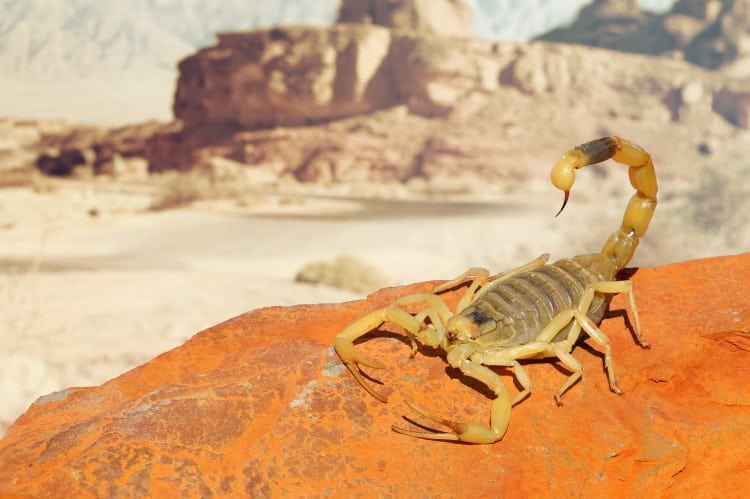
Scorpions can be referred to as living fossils because they have changed their form so little in the last 400 million years.
Scorpions can be found on all major land masses, other than Antarctica, and in many different habitats. From high on mountains at elevations up 5,500 metres or 18,000 feet; to the sea shore; from the driest deserts to tropical rain forests; from 40 metres or 130 feet up a tree; to 800 metres or 20,000 feet below ground, in a cave.
Scorpions are really ‘laid back’ about life and really do not believe in putting out more effort than is really necessary – they have in fact some of the lowest metabolic rates ever recorded in an animal.
Most species stay within 1 metre of their burrows and some may spend as much as 97% of their lives inside their burrows. Some species can go as long as a year without food and some can live indefinitely without water, deriving all the moisture they need from their prey.
Many scorpions are ideally suited to surviving in a habitat where food may become available only infrequently. Scorpions also tend to be long lived for their size, and the females put a lot of effort into raising the young.
These facts combine to give scorpions a long generation time and a low rate of population increase. In fact some scorpions have the lowest maximum rate of population increase (rmax) ever recorded, lower even than the long lived vertebrates.
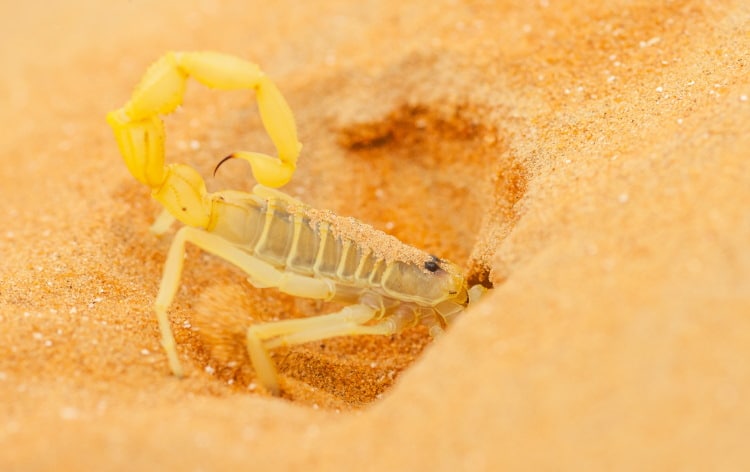
Another amazing things about Scorpions is that they have diversified to all these habitats, with very little change in their morphology. The basic body plan of Scorpions is the same now as it was 420 MYA, when they first appeared.
They tend to change their habits rather than their form, in order to adapt to a new habitat – which gives them something in common with us humans.
Most scorpions live solitary lives, but some are almost social and in most species the mother shows some degree of maternal care. The young of Scorpio maurus remain with their mother for 3 to 4 months. While the 2nd instar young of Didymocentrus caboensis in California have been observed living with and feeding with their mother, even to the extent of helping her drag the prey into the burrow.
Opisthacanthus cayaporum build communal chambers inside termite mounds and Pandinus imperator has been known to show similar tendencies. Other species like Centruriodes exilicauda have been found in groups of up to 30 during the winter; and up to 17 Lychas marmoreus have been found living together under a single piece of Eucalyptus bark in Australia.
There are currently 3 species of scorpion at least on the Convention on International Trade in Endangered species of Wild Fauna and Flora (CITES) appendices I and II, as adopted by the Conference of the Parties – making it illegal to trade in wild specimens. These are:
- Pandinus dictator, Pandinus gambiensis and Pandinus imperator
Scorpion Facts And World Records
- Heaviest body: Probably Hadogenes troglodytes, a non-gravid female may weigh 32g and be 21 cm (8.5 inches) long.
- Biggest Scorpion (Longest body): Heterometrus swammerdami, A specimen from India measured in at 29.2 cm or 11.5 ins. Pandinus imperator has been recorded at 22.9 cm or 9.01 ins.
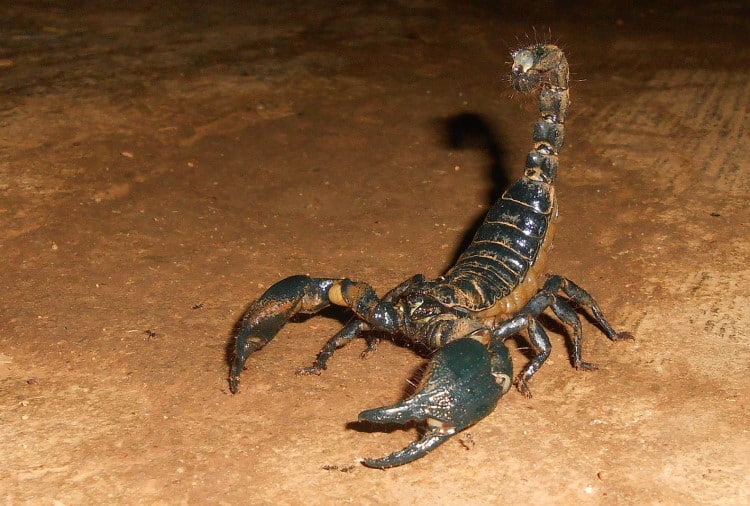
- Smallest Scorpion: Typhlocactus mitchelli, 8.5 to 9.0 mm (less than 0.5 inches) in total length.
- Longest lived: Urodacus yashenkoi, up to 24 years.
- Gestation period: 3 to 18 months
- Time to maturity: 6 to 96 months
- Highest elevation: Orobothriuris crassimanus, 5,500 m in the Andes
- Greatest depth below ground: Alacran tartarus, 812 m
- Highest density of species: Baja California, 13 species.
- Worst reputation: Androctonus australis
- Most dangerous poisonous: Leiurus quinquestriatus
- Most dangerous place: Mexico, as many as 1000 people die from Scorpion sting every year.
Evolution and Ecology
The first Scorpions are believed to have evolved from the Eurypteridae or water scorpions, 425 to 450 million years ago in the middle of the Silurian epoch. The first Scorpions were most probably marine and marine members of the family continued to exist until about 250 to 300 million years ago.
The first terrestrial Scorpions could most likely be found by about 340 million years ago. As with most arthropods, early scorpions produced some very large species; and the largest fossils found so far indicate about 1 metre or 3 feet as the maximum length i.e. Brontoscorpio willsi.
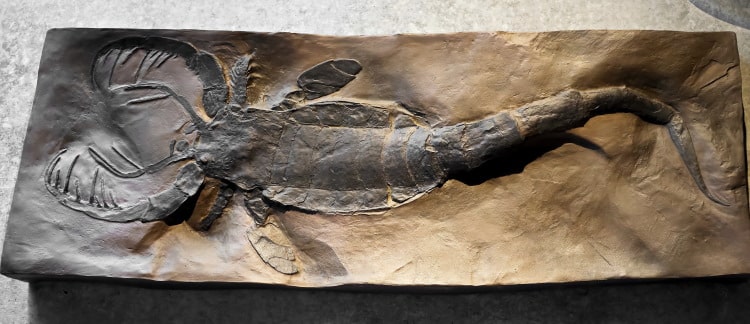
As Scorpions are entirely predatory, they could not be the first to make use of the new terrestrial habitat – but could only move up out of the sea after sufficient prey species had gone before them (these would most likely have been insects, arachnids and millipedes). The earliest known terrestrial scorpion is Palaeopisthacanthus, from the upper carboniferous.
Some species still live near the sea, hunting in the littoral zone of the seashore – keeping company with the crabs and periwinkles i.e. Euscorpius carpathicus.
There is argument among the experts as to whether or not scorpions really are arachnids. Some maintain that they are an ancestral stem group of the Arachnida, while others claim they are actually the only living relatives of a distinct class called the Merostomata.
For the time being it is quite acceptable to consider scorpions as a distinct group “Scorpionidae” within the Arachnida
One way of roughly dividing the scorpions into two groups, is to distinguish between those that live in holes and crevices in the ground and those that live in or on plants.
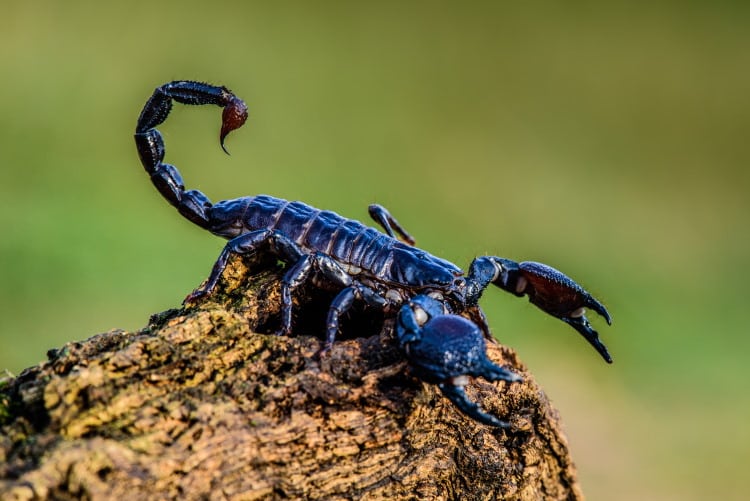
An example of a plant dwelling species is Liocheles australiensis, which has been recorded as high as 40 m (130 feet) above ground in the pine tree Araucaria huntsteinii in Australia. The familiar pet shop species Pandinus imperator is a ground dwelling species.
Other words you may find associated with scorpions are:
- Lithophilic (rock loving); this describes species which specialise in rocky areas and which tend to have long legs, long thin chelae and a dorso-ventrally (top to bottom) flatted body;
- Psammophilic (sand loving); with large tarsal claws and numerous setae (stiff hairs);
- Fossorial (designed for digging); these species tend to have large crab-like chela and short solid legs.
If you look at a lot of scorpions, you will of course find many species that do not fit exactly into any of these general descriptions. Having said all this, some species of scorpion show a remarkable adaptability; on Sorroco Island (California) there is only one species of scorpion, Vaejovis janssi, which can be found in all habitats; in the jungle either in trees and other vegetation, on the ground, in the sand, among the rocks, and on the seashore.
Scorpio maurus also occupies a great range of habitats, from below sea level in Israel to 3,000 m (10 000 feet) above sea level in the Atlas mountains.
Some species of scorpions can survive being super-cooled for several weeks, immersion in water for two days or temperatures higher than most arthropods can survive. These characteristics, along with the versatility of their general body plan, make scorpions extremely successful predators in some habitats.
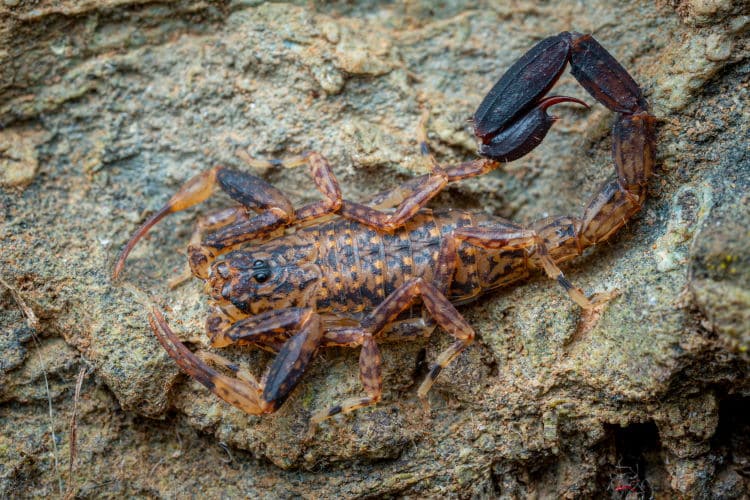
Most predation on young instars is in some habitats by older/larger scorpions, often of the same species. Scorpions have no morals about food: if you eat it before it eats you, then do – is the general rule.
Not all species are so cavalier though, Isometroides vescus specializes on trap-door spiders, taking over the spider’s home as a new temporary burrow after eating the original owner.
Burrows are a very important aspect of the ecology of desert scorpions.
Burrows take time and energy to build, but in return they retain a higher humidity, lower temperature and protect the owner during its moult. Some species may burrow as deeply as 1m into the ground, though not straight down.
Desert scorpions are also extremely good at conserving water; in fact they are better at it than any other arthropod. Many scorpions spend more than 80% of their lives in their burrows. They generally only leave their burrows at night and often do not go very far from the entrance.
Little is known of how they navigate, but it is known that Androctonus sp. can navigate using the light of the moon and the stars. Scorpions breath through special organs called book lungs.
Courtship is usually initiated by the male, but in some cases it may be the female who approaches the male. In a number of species such as Vejovoidus longiunguis and Nebo heirichonticus, the male indulges in some pre-promenade ‘juddering’ – a series of rapid rocking or shaking movements.
This juddering causes vibrations in the substrate, which tell the female that the nearby animal is an adult male of the same species looking to mate.
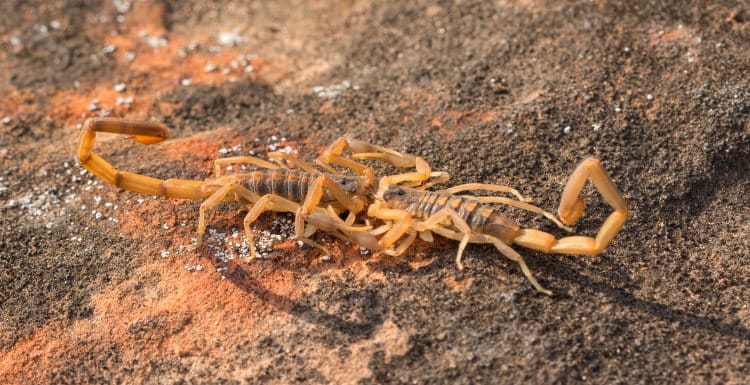
During courtship, other ritual activities may be observed. Among these are:
- Clubbing
- Sexual stinging
- Cheliceral massage
- Promenade a deux (courtship dance)
- Postmating escape
- Mate cannibalism
Clubbing involves one partner striking the other with the metasoma (the tail) without stinging; this occurs in 45 percent of observed cases.
Sexual stinging involves the male inserting his sting into the female through a membrane, normally one on the pedipalp. The sting may remain embedded in the female for up to 20 minutes; it is not known whether envenomation occurs. This occurs in 21 percent of observed cases.
Cheliceral massage involves the male grabbing and kneading the female’s chelicera and/or parts of her pedipalps with his chelicera (often referred to as ‘kissing’); this occurs in 86 percent of observed cases.
Postmating escape is where one partner disengages suddenly and sometimes violently (stinging and clubbing may be involved) from the other partner and rapidly makes a get-away, after the spermatophore has been taken up. Normally it is the smaller partner who makes the get-away; this has been observed to be performed by males in 36 percent of cases and females in 21 percent of cases.
Mate cannibalism involves the female capturing and eating the male after successful sperm transfer; and has been noted to occur in 39 percent of species observed.
The courtship dance, called the ‘Promenade a deux’ involves the pair gripping each other with their ‘pedipalp chelae’ (claws) and – lead by the male – walking backward and forward in tandem, until a suitable place is found for the male to deposit his spermatophore. This is a small bag of sperm which the female will pick up with her genital opening.
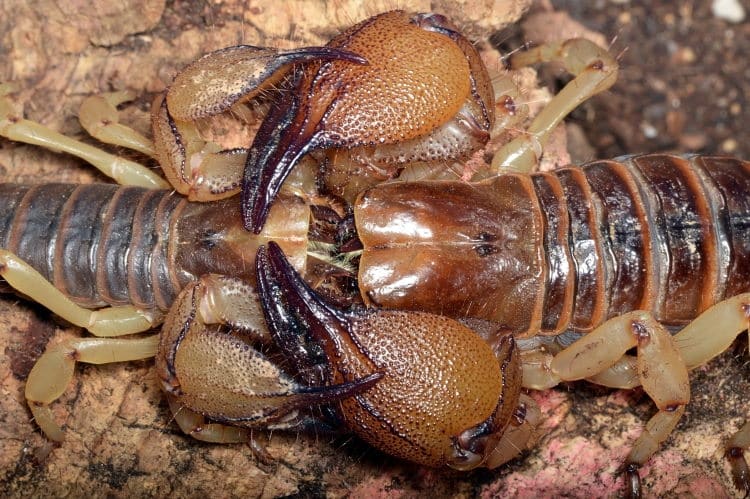
In at least some species, i.e. Opisthothalmus latimanus, the male has been shown to respond to the scent of the female. It has also been shown that, in species of Tityus, pheromones allow males to distinguish between fertilised and unfertilised females.
Reproduction
After mating, there is a fair chance that the male will be eaten by the female. Though the degree to which this happens varies with species; it has been the end result of 39% of observed matings.
Ecologically, this can be to the male’s favor if there is little chance of him finding and mating with another female – because it ensures that the female is well fed and thus likely to produce strong, surviving offspring.
However, male scorpions can mate more than once if given the opportunity and one male Tityus bahiensis was seen to mate 11 times in 102 days.
A few scorpions such as Lychas tricarinatus are parthenogenetic, which is a natural form of reproduction where females give birth without mating with a male.
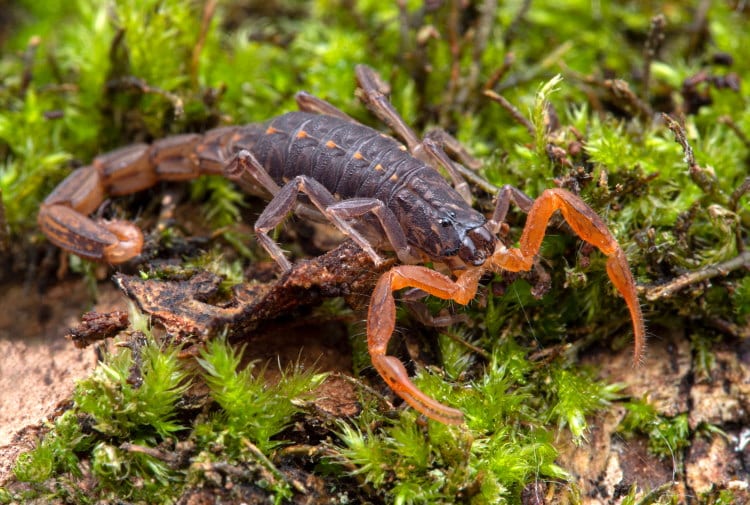
Embryonic development occurs in two different ways in scorpions, either apoikogenically (where the ova has some yoke and the young are born enclosed in a birth membrane) or katoikogenically (where there is no yoke and no birth membrane).
It has been shown that even in apoikogenic species like Centruroides, some nutrients are taken up by the developing embryo directly from the mother’s system – even though the ova are supplied with yokes.
Katoikogenic development involves the use of specialised diverticula, that branch of from the female ovariuterus – and through which the developing embryo receives all its nutrients (unlike apoikogenic development where the embryo is in direct contact with the ovariuterus).
The fact that apoikogenic embryos receive some nutrients from the mother’s system, means that all scorpions should be regarded as viviparous – though you may find apoikogenic scorpions referred to as ovoviviparous in some places.
Birth normally occurs in Spring and Summer in temperate areas, but in tropical climes scorpions can give birth all year round – though individual species seem to have preferred months.
Immediately prior to parturition (giving birth), the female assumes a posture known as ‘stilting’ in which she holds her head and the front of her body up off the substrate. At the same time, she will be flexing her pedipalps and her first or first and second pair of legs under her body near her genital opening – forming a ‘birth basket’.
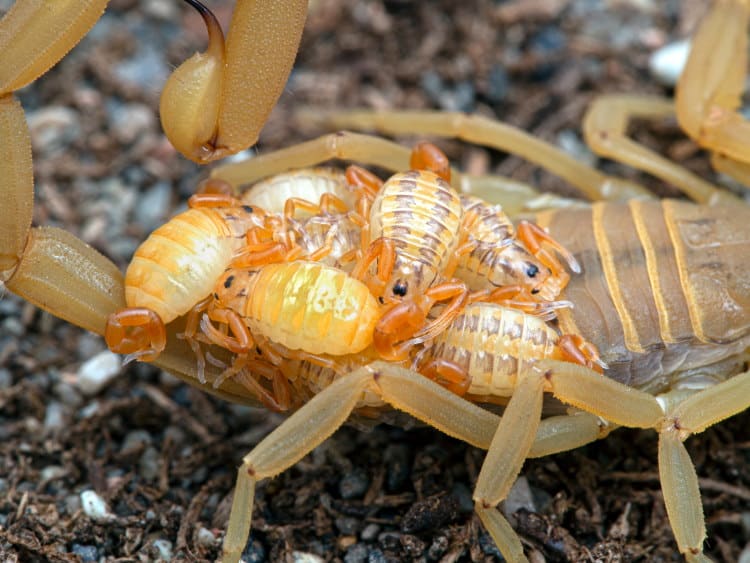
She will maintain this position until all the young scorpions are born. The young emerge one at a time, though they follow each other quickly or sporadically. Immediately on being born, those with a birth membrane struggle out of it; once free, the young ascend onto their mother’s back where they remain for their first moult.
They will leave their mother’s back in 3 to 14 days, depending on species. During this time the young, of some species at least, will absorb water from their mother.
There are a few exceptions to the habit of creating the birth basket in Old World species such as Compsobuthus acutecarinatus and Orthochirus innesi. In these cases, the young are born straight onto the substrate and not into their mother’s arms. However, the mother positions her legs so that the young find them easily and they soon ascend to her back.
Litter size is very variable between species and individuals. Observed data gives a range of between 1 and 105 young per birth, with an average of about 26. Sex ratio at birth is 1:1.
In some species, such as Isometrus maculatus, the females store sperm and can give birth to several litters through time following a single mating. Parthenogenesis is known to occur in Tityus serrulatus and Liocheles australasiae – and suspected of occurring in several other species.
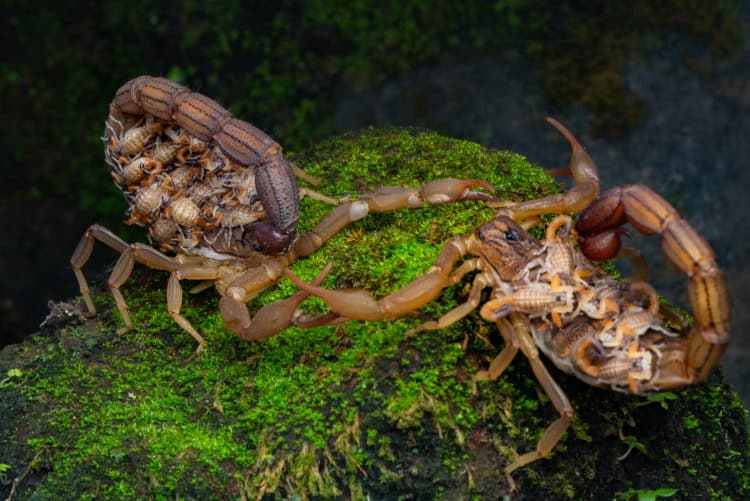
Females show maternal care and will replace fallen young onto her back.
Females are known to recognise their own young by smell. Males and other females, however, behave predatorily towards young scorpions. In some species such as Scorpio maurus palmatus, the young share the mother’s den for several months; while examples have been known of Didymocentrus comondae of 2nd instar young sharing, not only the mother’s burrow, but also her food.
Most deaths occur during these 1st two instars; and once into their 3rd instar they are fairly easy to rear. Most species have 5 instars as males and 6 as females. Growth rate is dependent on species, food intake and temperature; though it is not unusual for the large species to take over 3 years to reach maturity.
On reaching maturity, it is a general characteristic that females are larger than males.
Feeding Ecology
Most scorpion’s idea of hunting is to sit and wait for a likely prey item to bump into them. Naturally, this form of ‘hunting’ is very unselective and scorpions have a very diverse diet – though a number of species have been reported as rejecting thickly armoured beetles such as Darkling beetles( unless practically starved).
Apart from other arachnids, myriapods and insects, scorpions will eat isopods (woodlice), gastropods (slugs and snails) and small vertebrates i.e. snakes, lizards and rodents.
Prey is primarily detected by the vibrations it makes in the substrate; this also allows them to capture prey digging in the ground below the surface. Some species will take captured prey back into the burrow, i.e. Buthus occitanus. But others, like most of the North America vaejovids, will eat their prey where they catch it.
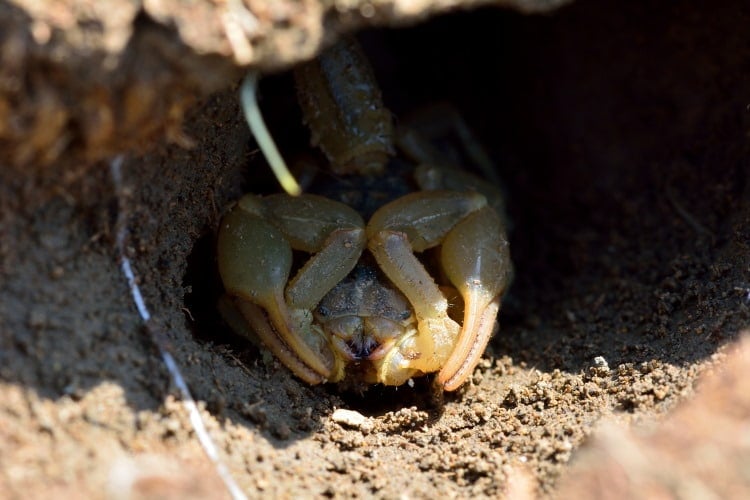
Scorpions which go out and hunt food, rather than sitting and waiting, are few; though some do prefer looking actively for their dinner i.e. Uroplectes otjimbinguensis and Opisthocanthus chrysopus. Once caught the prey is torn into small particles, which are collected in the preoral cavity – which lies just below the chelicerae.
Scorpions use external digestion; that is they spit or secrete digestive fluids onto the remains of their prey (which are held in the preoral cavity) and then suck up the resulting soup. Using this method they are extremely efficient at digesting their prey.
Scorpions can consume huge amounts of food at one sitting and excrete very little in the way of waste; what they do excrete is generally insoluble nitrogenous waste, such as xanthine, guanine and uric acid. All these factors combine to make their laid back life a success.
It is possible that scorpions are the greatest predators on other scorpions, but they are not by any means the only predators that feed on them. Because scorpions often store considerable fat reserves, they represent a good source of food if you can get away with eating them.
Some animals which actively hunt scorpions include the lizard Varanus goldii, which actively seeks out Urodacus hoplurus in its burrow; while two other lizards, Nucras tessellata and Pygopus nigriceps are also scorpion specialists.
Baboons will turn over rocks to find them and Meerkats are quite fond of them as well. At night, they fall prey to owls such as Speotyto cunicularia and rodents such as the Grasshopper Mouse Onychomys torridus.
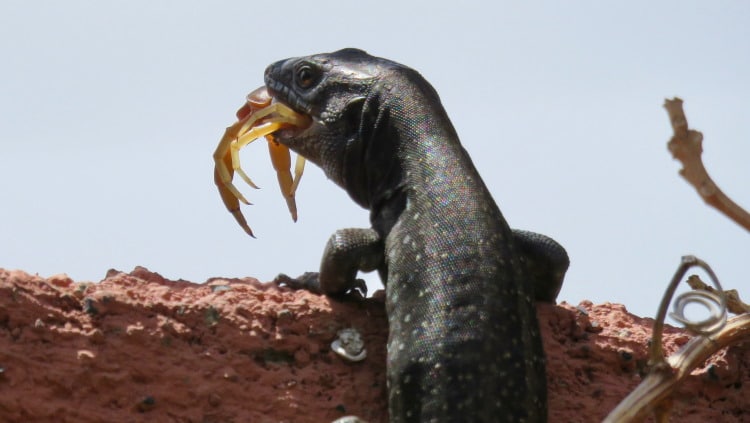
Scorpions are troubled by relatively few parasites and there are no reports (as of 1990) of insects parasites making use of scorpions. Scorpions have been recorded as being host to both nematode and mite parasites, with some species of mites such as Pimeliaphilus joshuae being found only on scorpions.
Scorpions have played an important role in the mythology of people who live with them since the earliest times.
The Chaldeans (Babylonia) grouped the major stars in the night sky into 12 constellations, one of these was Scorpio containing the bright red star Anteres. This is an indication of how potent a force the scorpion had become in people’s minds 4,000 years ago.
The 12 houses of the Zodiac in Astrology are derived from these star configurations and Scorpio is still among them. No insect has aspired to this claim, though another arthropod has i.e. Cancer the Crab.
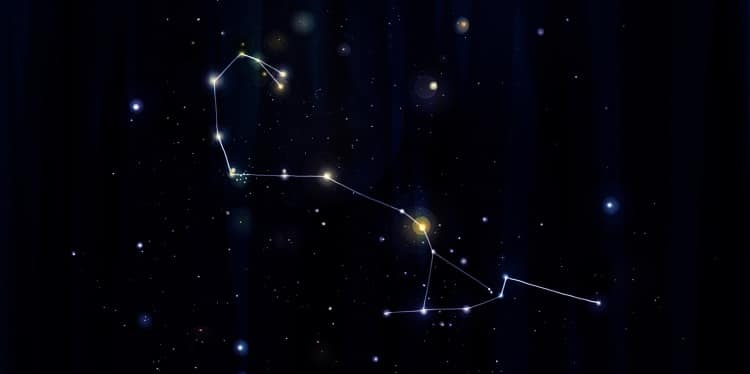
The warrior-god Sadrafa is depicted on a stele from a temple of Bel, Palmyra dated to AD 55, with his attributes the scorpion and the serpent. He is however a much older mythological figure than this, being a forerunner of the Iranian Mithras – by which time however he had lost his association with scorpions.
In an ancient Persian legend, Mithras the Persian god of light sacrificed the sacred bull in order that his blood might fertilize the universe – thus creating life. However the evil Ahriman, in order to destroy this life, sent a scorpion to sting the bull on the testicles. Mithras remained a popular god throughout the Mediterranean area, particularly with Roman soldiers, and was actively worshiped until about 500 AD.
The scorpion is frequently seen as the agent of the devil.
In ancient Egypt, representations of scorpions are frequently found on tombs and monuments. There is a section in the ‘Ebers papyrus’ entitled “How to Rid the House of Scorpions” and scorpions are mentioned in several passages in the ‘Book of the Dead’ as well as in the Talmud and the Bible Old Testament.
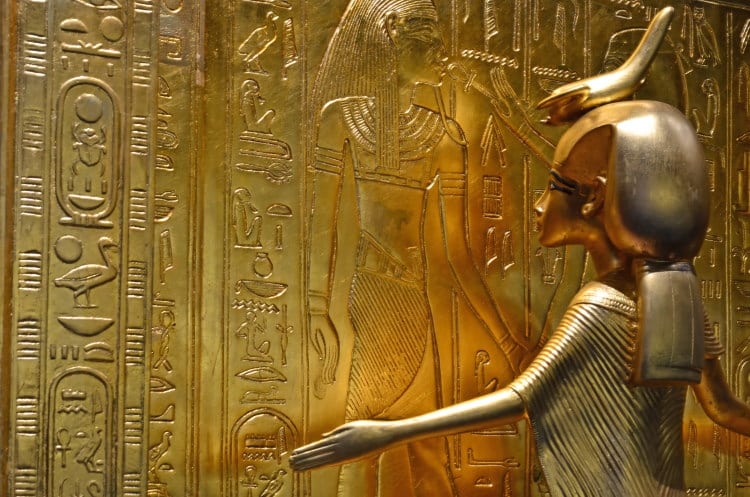
The Egyptians also had a scorpion-goddess called Selkit or Serqet, who was ‘friend of the dead’ and whose image often adorned artifacts relating to the mummification of the dead. She is sometimes depicted with a stylised scorpion on her head.
A fine example of this is the cabinet containing the viscera of the Pharaoh Tutankhamen (shown above).
More commonly, people in Egypt believed until relatively recent times that scorpions originated from the bodies of dead crocodiles. While in Europe they believed that dead crabs turned into scorpions.
These myths reflect the fact that scorpions are not fussy about where they look for food and shelter – and under a dead crocodile or crab was/is probably quite a reasonable place.
In Hebrew ancient history, the scorpion was the emblem of the tribe of Dan. There is also a character ‘Scorpion Man’, guardian of Mount Mashu – the place of sunrise and sunset in the Gilgamesh epic. This character later plays a role in the Babylonian Creation Tablets (650 BC), when he is one of the 11 mighty helpers that assisted Tiamat the mother of creation in overcoming her loathsome offspring.
Images of the Scorpionman were used in artistry and a fine extant example is a harp found in the Royal Necropolis of Ur from around 2,600 BC (now in the Museum of the University of Pennsylvania).
Scorpionman images also adorned the flanks of the Temple Palace of Kapara, king of the Assyrian city of Guzana. The basis of much of this attention to scorpions was fear: scorpions caused death with seemingly little effort.
In Syria (where the province of Commagene had the scorpion on one of its coins about 100 AD) it was so feared, that in some places, it was allowable to kill scorpions even on the sabbath – and even if they had not initiated an attack.
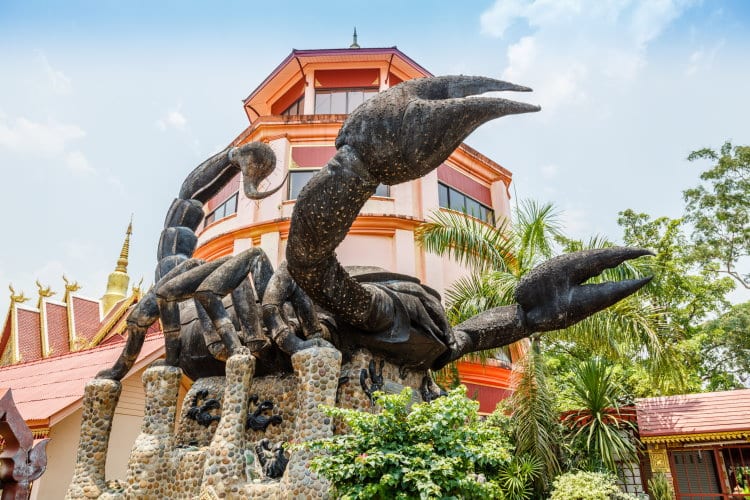
Scorpions also feature in ancient Chinese writings where they are linked with the toad, the centipede, the snake and the spider – to form the Wu Tu or 5 poisonous animals. Much later, the great Chinese encyclopedia of 10,000 volumes (Ku Chin T’u Shu Chi Ch’ang) produced in Peking in 1726 devoted 14 pages to scorpions.
According to Ancient Greek mythology, Zeus’ son, Orion the Hunter, was killed by a scorpion produced by the Goddess Artemis after he had raped her.
All the ancient Greek and Roman scholars, such as Aristotle and Pliny, wrote of scorpions with varying degrees of accuracy. Pliny the Elder claimed that the scorpion’s sting was always fatal to girls and women, but was only to men in the morning. The scorpion which inspired these tales would most probably have been Scorpio maurus.
For a period of about 300 hundred years from the early 1300s to late 1500s, Christians often used the scorpion as an emblem for the Jewish people to symbolize perfidy.
Pliny believed in a number of cures for the affects of the scorpions sting, including Aconite and Basil. This was still being reported in the 17th century. In the 16th century, John Lyly writes that “By Basill the Scorpion is engendered; and by means of the same hearb destroyed”.
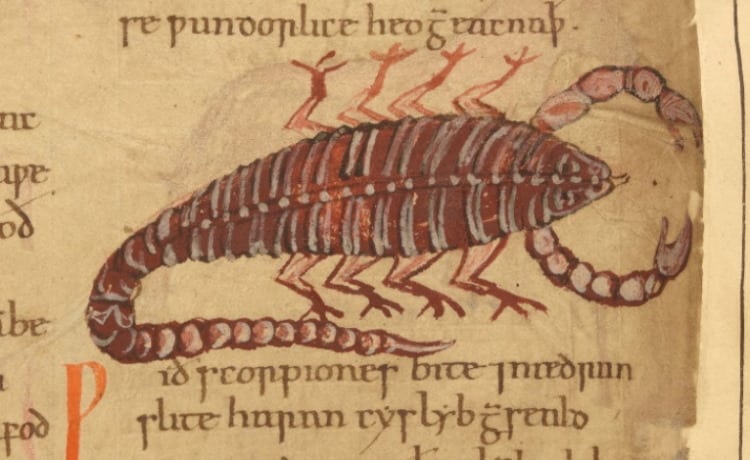
In the middle ages, there were numerous scorpion based cures. The plant Scorpion Grass got its name from its supposed ability to cure scorpion stings. It was also believed that an oil could be extracted from a scorpion, that could be used as a cure for the sting. This related to a similar belief that the scorpion’s tail could be used to cure the affects of the sting.
Many ancient myths about scorpions were still being retold until relatively modern times.
Among these was the belief that a scorpion surrounded by a ring of fire would sting itself to death (as scorpions are immune to their own stings, this is highly unlikely). They would of course get highly agitated. Other myths include the suggestion that scorpions don’t drink – and that black ones are more deadly than pale coloured ones. In fact, as a general rule the opposite is true.
The first person to make a serious attempt to study scorpions after Aristotle, was Francesco Redi who wrote intelligently of his observations in 1671. Following this, Pierre-Louis de Maupertius, published his seminal work “Experiences sur les Scorpiones” in 1733.
It was in 1810 that Latreille set up scorpions as an order in their own rite, as part of the class Arachnida – where we still classify them today. Linnaeus back in 1758 had scorpions as a genus of insects, with 5 species.
Since Latreille, the study of scorpions has improved considerable and today we know quite a bit about their biology and ecology.
- The Biology of Scorpions. by G.A. Polis (Ed.) (1990)
- Simply Scorpions A Guide for the Beginner. By Kathleen Hancock and John Hancock (1996)
- Fauna Palaestina: Arachnidae 1 Scorpiones. By G. Levy and P. Amitai (1980)
- Fauna of British India. Arachnida: Scorpiones, Uropygi, Amblypygi, Solifugae, Araneae. By R.I. Pocock.
- Faune de Madagascar: Fasc. 87 – Scorpions (Chelicereta, Scorpiones). By Wilson R. Lourenco (1996)
- Fauna of British India. Arachnida Volume 3: Scorpions-Arachnids. by B.K. Tikader and D.B. Bastawade (1983)
- Scorpions (Arachnida) from Costa Rica. by Oscar F. Francke and Scott A. Stockwell.
- Notes on the taxonomy of some old world scorpions (Scorpiones: Buthidae, Chactidae, Ischnuridae, Scorpionidae). By Fet V. in JOURNAL OF ARACHNOLOGY, 1997, Vol.25, No.3, pp.245-250
- Ecophysiological adaptations to dry thermal environments measured in two unrestrained Namibian scorpions, Parabuthus villosus (Buthidae) and Opisthophthalmus flavescens (Scorpionidae). By Bridges C.R., leRoux J.M.and vanAardt W.J. in PHYSIOLOGICAL ZOOLOGY, 1997, Vol.70, No.2, pp.244-256
- Relationships between morphology and feeding-behavior in the syntopic scorpions urodacus-armatus pocock and urodacus-novaehollandiae peters (scorpiones, scorpionidae). By Quinlan T.G., Smith G.T.and Calver M.C. in journal of the australian entomological society, 1995, Vol.34, No.Pt4, pp.277-279
- The female reproductive-system of the eastern Australian scorpion. by Aarburg M.R.and Rosenberg M in tissue & cell, 1994, Vol.26, No.5, pp.779-783
- The female reproductive-system in Scorpio-maurus-fuscus (Scorpiones, Scorpionidae). by Warburg M.R., Rosenberg M in Israel Journal of Zoology, 1993, Vol.39, No.1, pp.23-27
- Sensory projections of identified coxal hair sensilla of the scorpion Heterometrus-fulvipes (scorpionidae). by Babu K.S, Sreenivasulu K.and Sekhar V in Journal of Biosciences, 1993, Vol.18, No.2, pp.247-259
- The quaternary structure of Scorpio-maurus hemocyanin – comparison with Androctonus-australis hemocyanin. By Maaroufi H.and Lamy J.N. in Comparative Biochemistry and Physiology b-biochemistry & molecular biology, 1993, Vol.104, No.2, pp.215-227
- Potential lifetime fecundity and the factors affecting annual fecundity in Urodacus-armatus (Scorpiones, Scorpionidae). By Smith G.T. in Journal of Arachnology, 1990, Vol.18, No.3, pp.271-280
- Functional-morphology of the appendix of the viviparous scorpion, Heterometrus-fulvipes (koch) (Arachnida, Scorpionidae). By Subburam V. and Reddy T.G. in International Journal of Insect Morphology & Embryology, 1989, Vol.18, No.5-6, pp.329-333
- Cytogenetics of Australian scorpions .2. Chromosome polymorphism in species of Urodacus (family Scorpionidae). By Shanahan C.M. in Genome, 1989, Vol.32, No.5, pp.890-900
- Albinism and eye structure in an Australian scorpion, Urodacus yaschenkoi (Scorpiones, Scorpionidae). By Locket N.A. in Journal of Arachnology, 1986, Vol.14, No.1, pp.101-115
- Prey capture and stinging behavior in the Emperor scorpion, Pandinus imperator (koch) (Scorpiones, Scorpionidae). By Casper gG.S. in Journal of Arachnology, 1985, Vol.13, No.3, pp.277-283
- Reproductive-biology of the viviparous scorpion, Liocheles australasiae (Fabricius) (Arachnida, Scorpiones, Scorpionidae) .1. absence of males in 2 natural-populations. By Makioka T.and Koike K. in International Journal of Invertebrate Reproduction and Development, 1985, Vol.8, No.6, pp.317-323
- The circadian-rhythm of locomotory activity in a neotropical forest scorpion, Opisthacanthus sp (Scorpionidae). By CloudsleyThompson J.L.and Constantinou C. in International Journal of Biometeorology, 1985, Vol.29, No.1, pp.87-89
- Stridulatory structures in scorpions of the families Scorpionidae and Diplocentridae. By Constantinou C. and CloudsleyThompson J.L. in Journal of Arid Environments, 1984, Vol.7, No.4, pp.359-364
- Insect toxic components from the venom of a chactoid scorpion, Scorpio maurus palmatus (Scorpionidae). By Lazarovici P., Yanai P., Pelhate M.and Zlotkin E. in Journal of Biological Chemistry, 1982, Vol.257, No.14, pp.8397-8404
- Phospholipases and direct lytic factors derived from the venom of the scorpion Scorpio maurus palmatus (Scorpionidae). By Lazarovici P., Lester D., Menashe M., Hochman Y.and Zlotkin E. in Israel Journal of Zoology, 1981, Vol.30, No.1-2, p.112
- Toxins specifically active in arthropods and mammals, from the venom of the scorpion Scorpio maurus palmatus (Scorpionidae). By Lazarovici P. and Zlotkin E. in Israel Journal of Zoology, 1981, Vol.30, No.1-2, pp.111-112
- Panoramic view of the composition and action of the venom of the scorpion Scorpio maurus palmatus (Scorpionidae). By Lazarovici P. and Zlotkin E. in Israel Journal of Zoology, 1981, Vol.30, No.1-2, p.98
Cover image Heterometrus sp. Courtesy of, and ©, Vichea Sok; H. swammerdami image license (credit: Nireekshit) : Creative Commons



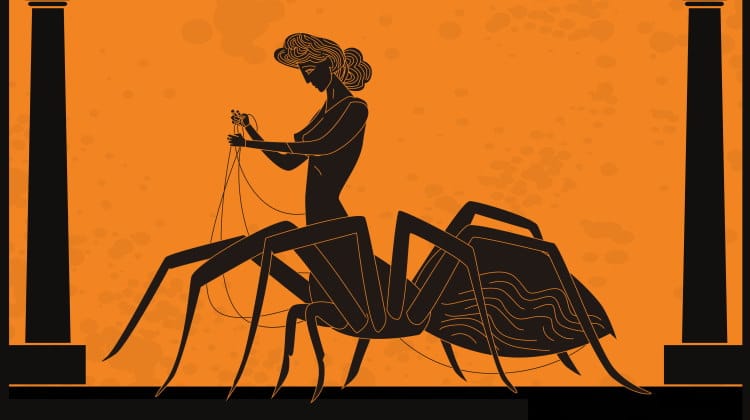
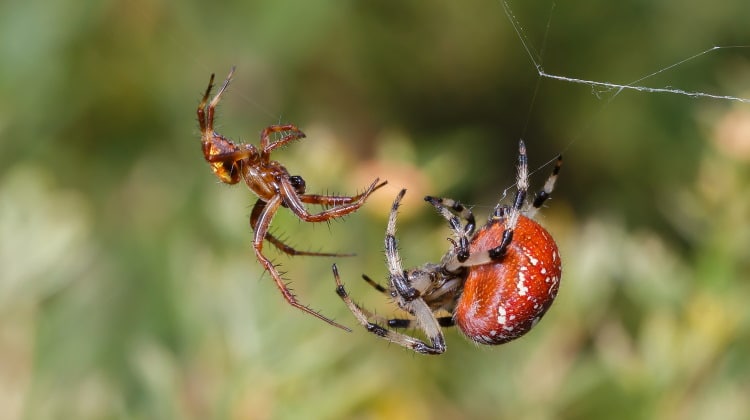
I’ve enjoyed reading this website. Thanks for sharing this information. I have been photographing the feral population of non-native Yellow-Tailed Scorpions (Euscorpius flavicaudis) in the UK for about 10 years now. Fascinating creatures! You can read of these introduced scorpions to the UK on my website.